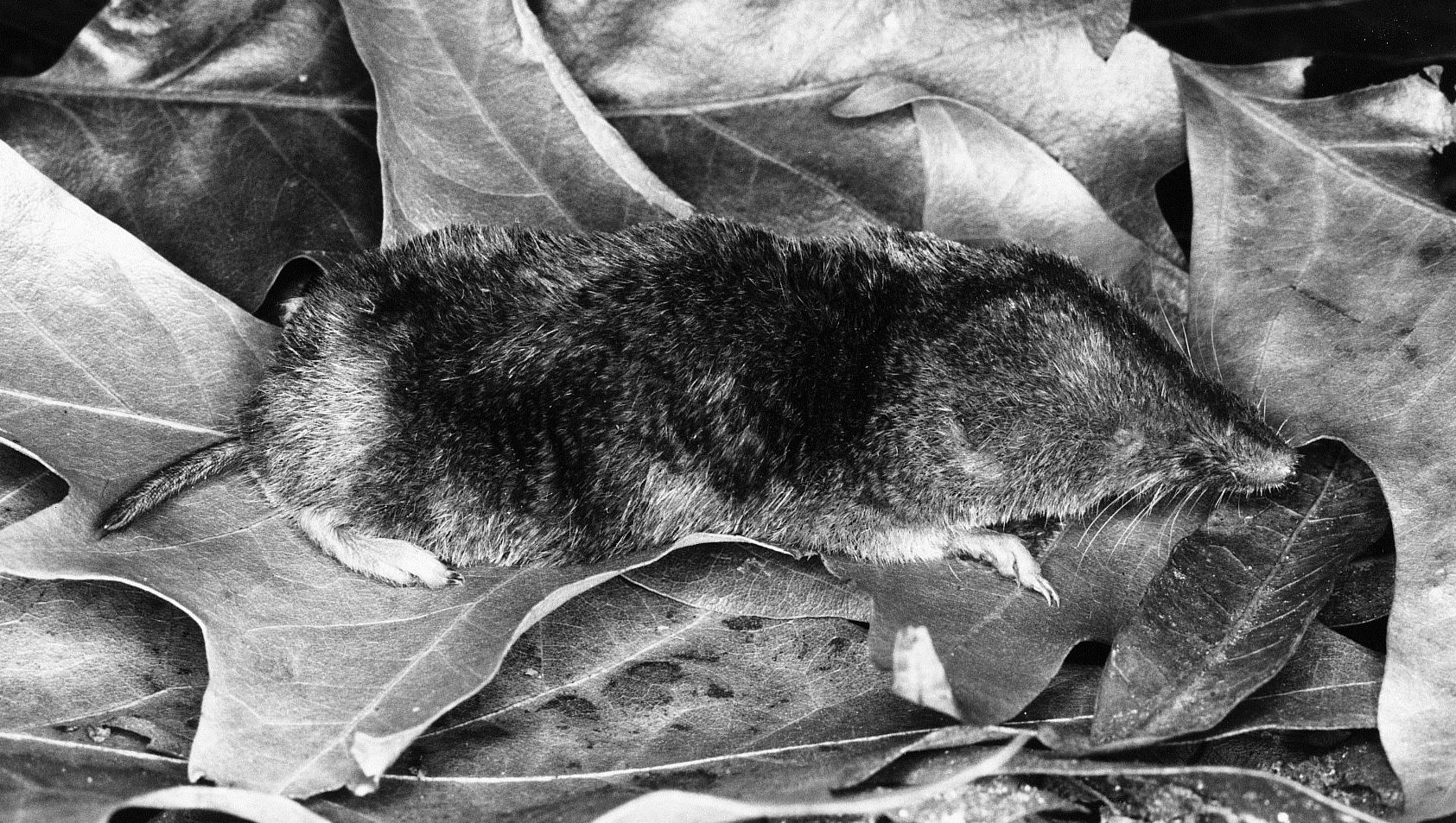SOUTHERN SHORT-TAILED SHREW
Blarina carolinensis (Bachman 1837)
Order Soricomorpha : Family Soricidae
DESCRIPTION. A rather robust, short-legged, short-tailed shrew with long, pointed, protruding snout; external ears short and nearly concealed by the soft, dense fur; tail less than half the length of head and body, usually less than twice as long as hind foot; upperparts dark slate to sooty black, often tinged with brown; underparts paler; tail black above, paler below. Dental formula: I 4/2, C 1/0, Pm 2/1, M 3/3 × 2 = 32. Averages for external measurements: total length, 88 mm; tail, 17 mm; hind foot, 11 mm. Weight, 18–28 g.

DISTRIBUTION. Eastern one-fourth of the state, with a disjunct record from Bastrop State Park (Bastrop County).

SUBSPECIES. Blarina c. carolinensis in the northern part of the range in Texas (south at least to Nacogdoches County) and B. c. minima in the south.
HABITS. Short-tailed shrews occur in forested areas and their associated meadows and openings. Adequate cover and food appear to be more important in determining their presence than type of soil or vegetation.
Their burrows usually occupy two zones, one several centimeters below the surface or directly on it and the other at a deep level, often 40–60 cm below the surface. These two levels are joined at irregular intervals. Frequently, their runs follow just beneath a log, sometimes penetrating and honeycombing the log if it is rotten and easily worked.
Shrews are short legged and slow of gait but extremely active, running along with their tails elevated at an angle. A slow-walking person can easily overtake them. They are well adapted for digging; the front feet are wide, strong, and slightly larger than the hind feet. Burrowing is accomplished by the combined use of forefeet, head, and nose. Timed individuals were capable of burrowing at the rate of about 30 cm per minute in soft soil.
Like the least shrew (Cryptotis parva), Blarina carolinensis seem to be more sociable than long-tailed shrews. Several individuals seem to use a common burrow system and seldom do they fight when more than two are placed in a cage. It appears certain that the male and female remain together during the prebreeding season.
The food habits of these shrews are strangely un-shrew-like in that they consume relatively large quantities of vegetable matter (e.g., nuts and berries). Analyses of over 400 shrew stomachs from East Texas revealed the following items (expressed in percentages of occurrence): insects 77.6; annelids, 41.8; vegetable matter, 17.1; centipedes, 7.4; arachnids, 6.1; mollusks (mostly snails), 5.4; vertebrates (mice and salamanders), 5.2; crustaceans (mostly sow bugs), 3.7; and undetermined matter, 2.4. There is considerable evidence that B. carolinensis stores snails for winter use.
An interesting feature of this shrew is the venom produced by the submaxillary glands; it is present in the saliva and may be introduced into wounds made by the teeth. Injections of 6 mg of an extract prepared from the submaxillary gland are strong enough to kill mice, but there is little likelihood of the venom having any serious effect on humans.
The breeding season of B. carolinensis extends from February through November. There appear to be two and possibly three litters of two to six young produced in this period. The gestation period is probably between 21 and 30 days. The young are pink, blind, and helpless at birth, and they weigh slightly >1 g. They are relatively slow in developing; the eyes of young born in captivity were still closed on the 22nd day. The young are born in a special nest of grasses and other dry vegetation under a rotten log or stump or under the ground; in each instance, entrance to the nest is gained by way of an underground tunnel. These nests are much larger than the more commonly found resting nests. Records indicate that very few of these shrews attain an age of 2 years.
Since the reproductive potential is high in this shrew, one can assume that it has several natural predators. Known predators include the milk snake, black snake, red-tailed hawk, red-shouldered hawk, American kestrel, broad-winged hawk, barn owl, short-eared owl, barred owl, great horned owl, long-eared owl, screech owl, fox, weasel, and skunk. Doubtless, other species could be added to the list.
POPULATION STATUS. Common. Given the sporadic distribution (based on specimen records), it is difficult to determine whether the southern short-tailed shrew is widely distributed and seldom collected by biologists or if it occurs in isolated portions of its presumed range.
CONSERVATION STATUS. The IUCN lists the southern short-tailed shrew as least concern, and it does not appear on the federal or state lists of concerned species. This shrew remains common in portions of the Big Thicket of southeastern Texas and appears to be in good shape there. It is rare in Bastrop County, and that population bears watching in the future.
From The Mammals of Texas, Seventh Edition by David J. Schmidly and Robert D. Bradley, copyright © 1994, 2004, 2016. Courtesy of the University of Texas Press.
Natural Science Research Laboratory
-
Address
Museum of Texas Tech University, 3301 4th street, Lubbock, TX 79409 -
Phone
806.742.2486 -
Email
nsrl.museum@ttu.edu

